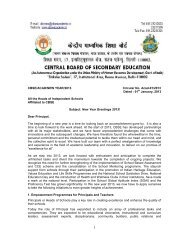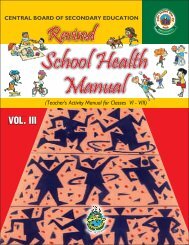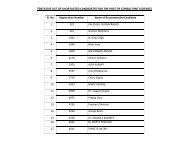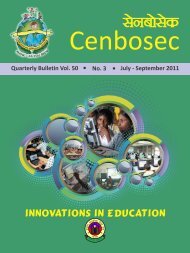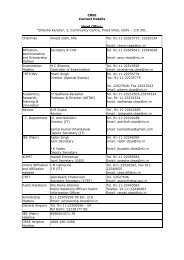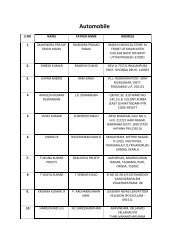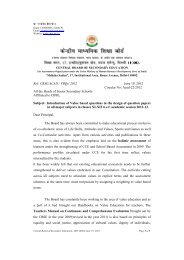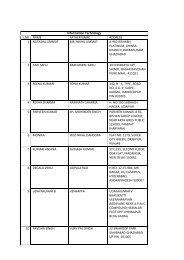CCE Manual VI - VIII - CBSE
CCE Manual VI - VIII - CBSE
CCE Manual VI - VIII - CBSE
You also want an ePaper? Increase the reach of your titles
YUMPU automatically turns print PDFs into web optimized ePapers that Google loves.
external, formative versus summative, and authentic versus objective. It shouldbe remembered, however, that the combination “internal/formative/authentic”is possible but not a necessary alignment of these distinctions. In other words,you can have internal assessment that is summative, and you can have internalassessment that is objective. But of course internal assessment is more likely tobe authentic than external examinations not only because the assessment isoccurring as close as possible to the learning but also because of the range ofassessment instruments available.Assessment tasks can be long or short, not necessarily written, done in a controlledassessment space or not, completed in a specified time or not, by studentsworking individually or in groups, with or without certain levels of teacherassistance, and so on. Student work may be an artifact, performance, oralpresentation, computer program, extended writing, project work, rich task,fieldwork, practical work, or other demonstration of mastery.Continuous and Comprehensive EvaluationSome personal attributes contribute to academic performance; for example, adedication to study can be acknowledged and recorded as an observed attributein a student; it should also lead to the student doing well in academic assessment.The academic assessment, however, should focus on actual achievement, ratherthan the personal attributes that contributed to it. In various educational systemsthe relative value attached to attributes and achievement may vary, but it isimportant not to get them confused with each other. Concerns are oftenexpressed or at least implied that judgments about personal attributes in aneducation context are biased. To the extent that such assessment is based onteachers’ personal observations of students from day to day, it is inevitable thatsome assessment will be affected by teachers allowing personal preferenceinfluence their judgments but this should not undermine the desirable validityof teacher judgments based on solid evidence.Writing a manual for teachers in an era of assessment reform is a balancingact. The authors must balance being too prescriptive and not being sufficientlyhelpful. They must provide information that is technically sound in educationalmeasurement terms and also practical for teachers at the “coal face”. Thismanual meets all those requirements and so I commend it to all teachersassociated with the <strong>CBSE</strong>’s assessment reform. I wish them well in theirx





